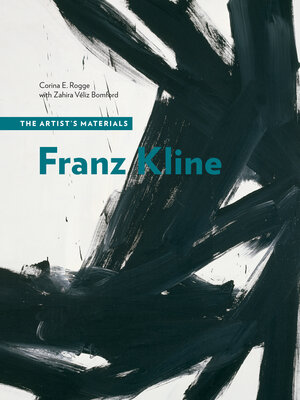
Sign up to save your library
With an OverDrive account, you can save your favorite libraries for at-a-glance information about availability. Find out more about OverDrive accounts.
Find this title in Libby, the library reading app by OverDrive.



Search for a digital library with this title
Title found at these libraries:
| Library Name | Distance |
|---|---|
| Loading... |
This book offers the most detailed investigation thus far of the materials and methods of this key American Abstract Expressionist artist.
Although Franz Kline was one of the seminal figures of the American Abstract Expressionist movement, he is less well known than contemporaries such as Jackson Pollock and Willem de Kooning. This is partly because Kline, unlike most artists in his circle, did not like to write or talk about his own art. In fact, when asked in a panel to discuss abstract art, Kline said, "I thought that was the reason for trying to do it, because you couldn't [talk about it]." Still, his impact was such that the critic and art historian April Kingsley wrote, "Abstract Expressionism as a movement died with him."
This volume, the newest addition to the Artist's Materials series from the Getty Conservation Institute, looks closely at both Kline's life and work, from his early years in Pennsylvania to his later success in New York City. Kline's iconic paintings are poised on a critical cusp: some have already undergone conservation, but others remain unaltered and retain the artist's color, gloss, and texture, and they are surprisingly vulnerable. The authors' presentation of rigorous examination and scientific analysis of more than thirty of Kline's paintings from the 1930s through the 1960s provides invaluable insight into his life, materials, and techniques. This study provides conservators with essential information that will shape future strategies for the care of Kline's paintings, and offers readers a more thorough comprehension of this underappreciated artist who is so central to American Abstract Expressionism.
Although Franz Kline was one of the seminal figures of the American Abstract Expressionist movement, he is less well known than contemporaries such as Jackson Pollock and Willem de Kooning. This is partly because Kline, unlike most artists in his circle, did not like to write or talk about his own art. In fact, when asked in a panel to discuss abstract art, Kline said, "I thought that was the reason for trying to do it, because you couldn't [talk about it]." Still, his impact was such that the critic and art historian April Kingsley wrote, "Abstract Expressionism as a movement died with him."
This volume, the newest addition to the Artist's Materials series from the Getty Conservation Institute, looks closely at both Kline's life and work, from his early years in Pennsylvania to his later success in New York City. Kline's iconic paintings are poised on a critical cusp: some have already undergone conservation, but others remain unaltered and retain the artist's color, gloss, and texture, and they are surprisingly vulnerable. The authors' presentation of rigorous examination and scientific analysis of more than thirty of Kline's paintings from the 1930s through the 1960s provides invaluable insight into his life, materials, and techniques. This study provides conservators with essential information that will shape future strategies for the care of Kline's paintings, and offers readers a more thorough comprehension of this underappreciated artist who is so central to American Abstract Expressionism.







